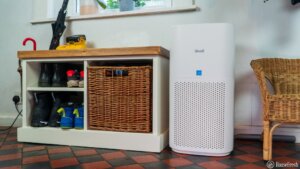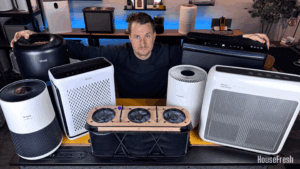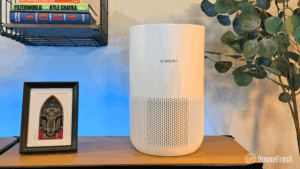Philips is a well-respected brand and is a Dutch multinational founded in 1891. At one point, it was the largest consumer electronics company in the world. That is not the case nowadays but the company is still big, with a revenue of 18.7 billion euros last year.
Philips sold the domestic appliance section of the business back in 2021 to a private equity firm (Hillhouse Investments). This appliance arm of Philips is now led by Versuni, so that is the company behind their air purifier range.
The 3200 is a stylish mid-sized device that promises performance on par with the larger, now-discontinued Philips 3000i Series. But is this all too good to be true?
The overall score for the Philips PureProtect 3200 Series (AC3220/10) incorporates first-hand data results from our battery of tests, as well as our ratings for customer service, brand transparency, and design & UX. Check out the full scorecard below to see the split of categories.
Search for the 3200 (or any other model you are researching) to see where it ranks:
The pros and cons of the Philips 3200
A summary of our top-level findings after testing this air purifier, following our methodology.
“After spending a few months with the Philips 3200 at home, I am convinced that it’s a significant upgrade to the now-discontinued 3000i.
You get the same level of air cleaning performance at a lower initial price with half the energy usage and cheaper long term costs.”

HouseFresh Founder
& Lead Tester
CONS
PROS
| Clean air delivery rate (CADR): | – Top speed PM1 CADR: 229 cfm – Sub-45 dBA PM1 CADR: 169 cfm – Manufacturer reporrted: 306 cfm |
| Filter technology: | Two bonded HEPA NanoProtect particle filters with a layer of activated carbon and a pre-filter mash wrap. |
| Recommended room size: | 373 sq. ft. (5 air changes per hour) |
| Dimensions: | 11.2 x 11.2 x 20.4 inches (28.5 x 28.5 x 52 cm) |
| Weight: | 13.7 lbs (6.2 kg) |
| Noise level in decibels from 3 ft. away: | Sleep: 35.4 dBA Medium: 42.6 dB Turbo: 52.9 dB |
| Electricity consumption in watts: | Standby mode: 1.1 watts Sleep: 2.2 watts Medium: 12.6 watts Turbo: 31.1 watts |
| Filter lifespan: | 12 months |
| Manufacturer’s warranty: | 2 years |
| Country of origin: | Netherlands |
| Country of manufacture: | China |
Filtration technology
The Philips 3200 comes with two 3-in-1 cylindrical filters that capture particles and reduce mild odors.
Upon removing the front cover, you will find two small 3-in-1 filters: an outer pre-filter mesh, a particle filter, and a carbon filter on the inside.
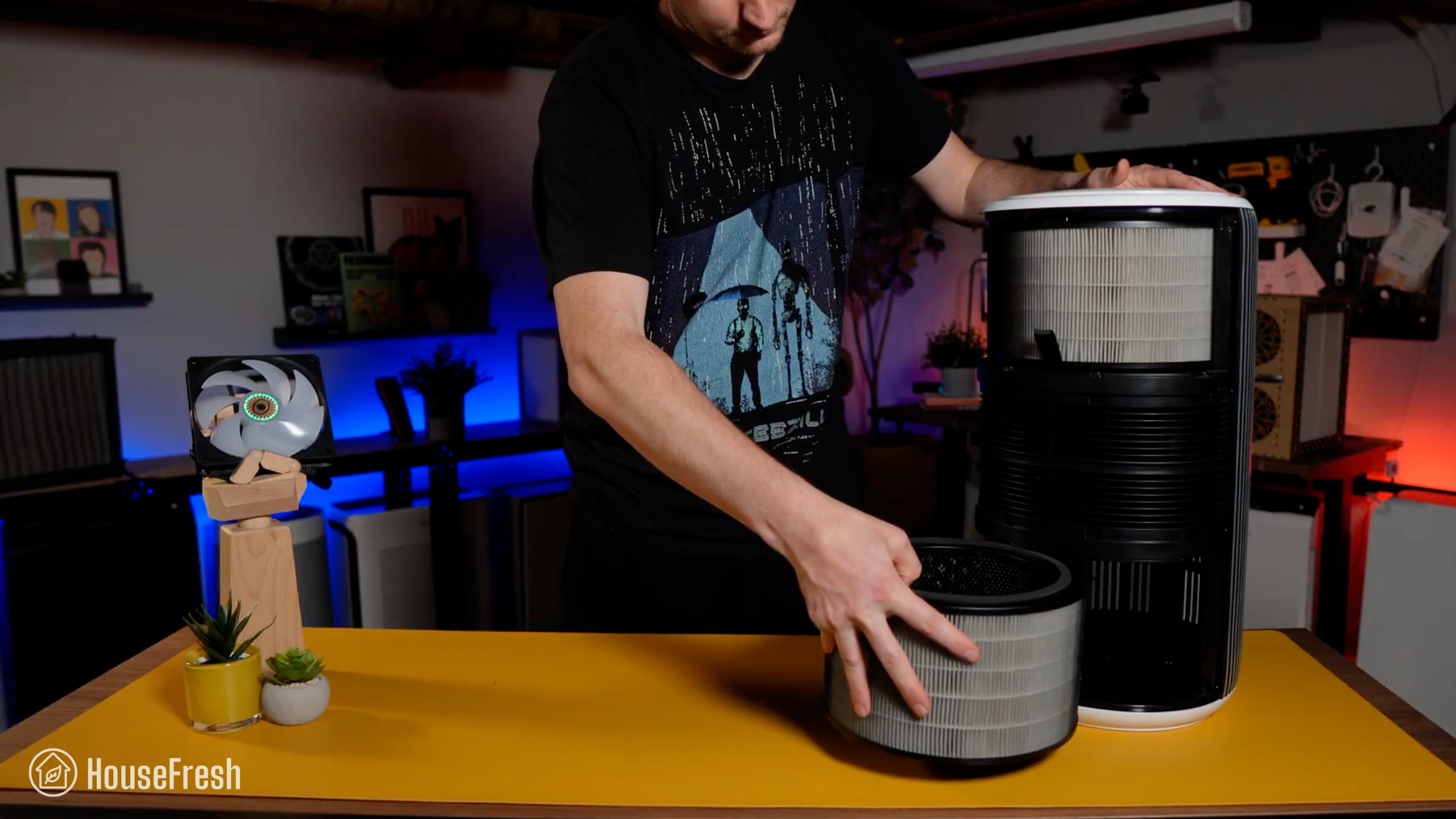
The filters are bonded, so you will need to replace the whole filter when the carbon runs out, which is usually earlier than the particle filter.
When I reached out to Philips, they told me that each cylindrical filter is packed with 50g of coconut carbon, which brings the total to 100 grams:

Philips stated that “coconut carbon is more effective than standard carbon, is renewable, and uses less energy to produce.”
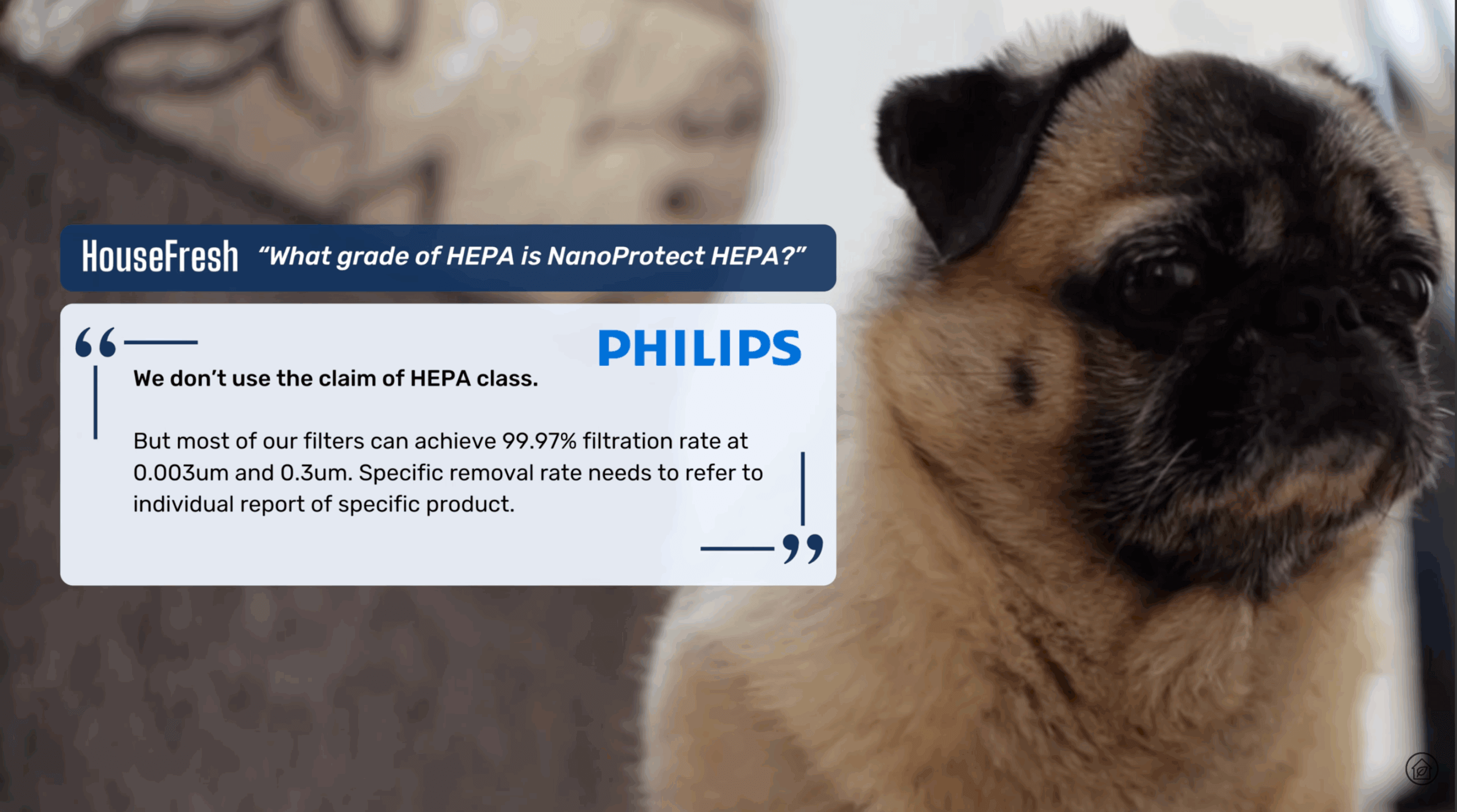
In terms of particle filtration, the 3200 uses the same HEPA NanoProtect filter used in other Philips air purifiers, which most people will assume is a certified HEPA filter.
However, Philips confirmed with us that it was not the case when I reached out for comment while working on my review of the Philips 3000i.
Marketing terms like ‘HEPA NanoProtect’ can be confusing to consumers, and mentions of how the filter “captures 99.97% at 0.003 microns” can be misleading because this level of particle removal can be achieved with a wide range of filter grades.
Design, controls and app features
A medium-sized cylindrical air purifier with smart functions, with a silver and black design that helps it stand out from the standard white we see from other brands.
The Philips 3200 (center) is a mid-size air purifier, similar in size to the Levoit Core 400S (right) and the Winix T810 (left).
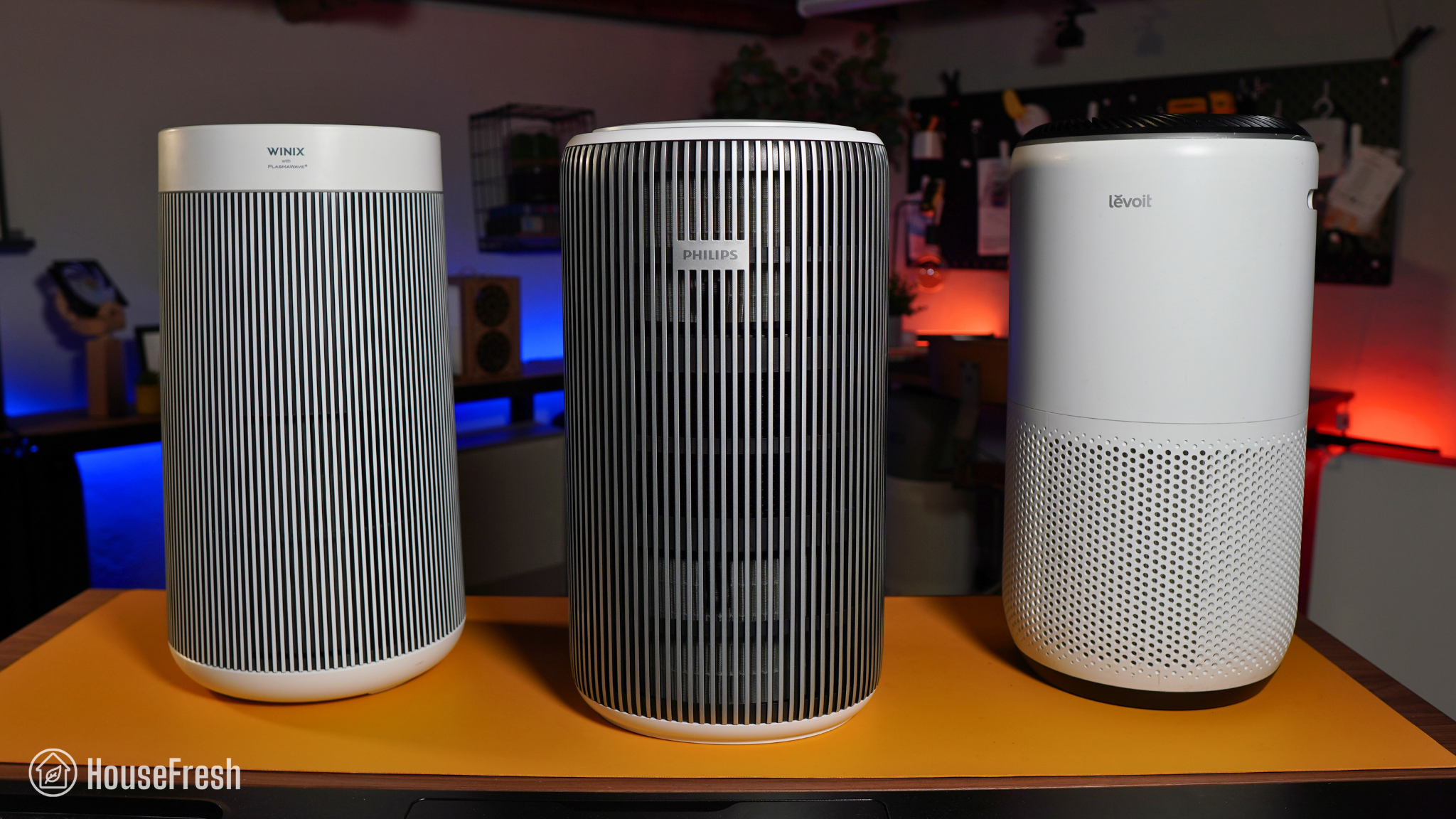
It weighs 6.2kg (13.6 lbs), so it’s not too heavy to move around — although I wish it had a handle somewhere so I wouldn’t have to carry it like a baby.
It comes with an optical sensor on the back, enabling auto-mode and PM2.5 readings, which are displayed at the top of the device.
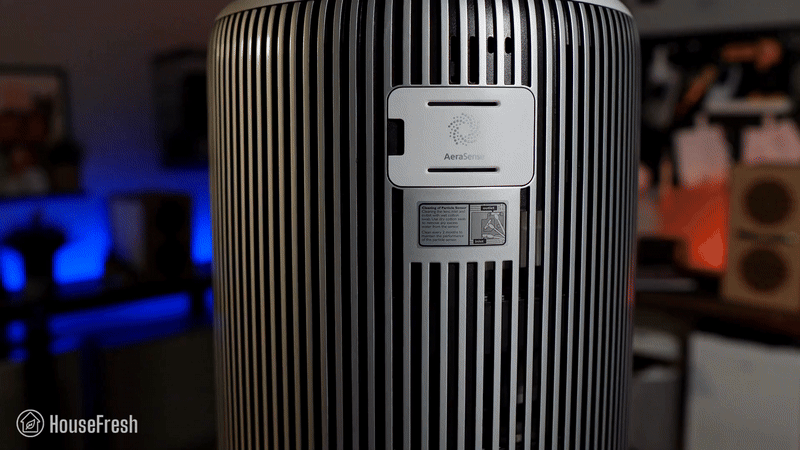
Optical sensors require regular cleaning to prevent dust buildup, which can affect their accuracy. Philips recommends cleaning it every two months with a dry cotton swab.
The LED ring at the top changes color based on the air quality in your room. Going from blue (good) to purple (fair) to red (poor).

If you prefer, you can also set the ring to be a lamp. When set to lamp mode, the top of the 3200 emits a nice, warm white glow.

Through the Philips Air+ App, you can set schedules for different modes, switch the light to lamp mode, and receive alerts when it’s time to clean the pre-filter.
You can also enable the Allergy Sleep mode, which supercharges the normal sleep mode by allowing the air purifier to reach a more powerful yet quiet fan speed when it detects PM2.5 in the air — unlike the standard sleep mode, which stays at a low fan speed regardless of the level of particles in the air.
Unlike most cylindrical air purifiers, the 3200 has two filters and two fans. Whilst I have seen two fans used in larger devices, this is the first time I have seen this dual-fan approach in a mid-sized device like this.
Read on to find out whether this two-fans-two-filters gamble paid off for Philips — and whether doubling the number of fans led to double electricity consumption…
Air cleaning performance
I tested the Philips 3200 in our 728 cubic ft. test room, tracking how fast it removed all PM1 particles from the air after we filled the space with incense smoke.
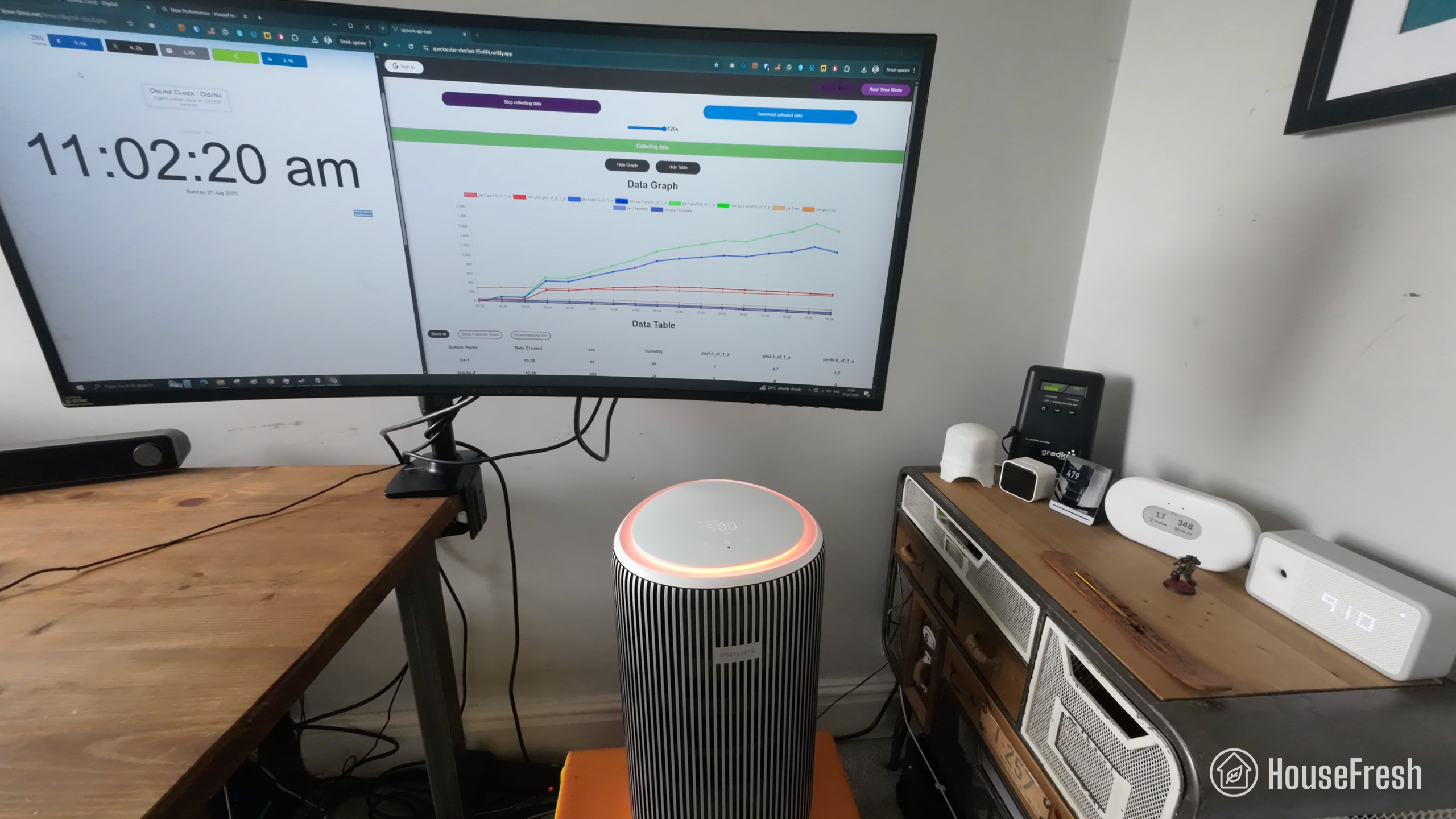
When running at Turbo speed, our PurpleAir Zen sensor shows that the 3200 needed 24 minutes to reach PM1 zero.
I was surprised to see that the 3200 matched the performance of the larger and more expensive Philips 3000i Series, which goes to show that the choice of using two fans and two filters paid off:

That said, you could get more powerful air cleaning with the Xiaomi Elite or the CleanAirKits Luggable XL-7, if you can afford the extra £40.
Based on the natural ventilation of our test room, we estimate a PM1 CADR of 229 cfm. This makes it powerful enough to provide five air changes per hour in rooms no larger than 373 sq. ft.
I repeated the particle removal test with the 3200 running at each available fan speed, allowing me to estimate PM1 CADR at each fan speed:

Sound levels
I measured how much sound the 3200 generates at each fan speeds from 3 ft. away — noise ranges from 35.4 dBA to 52.9 dBA at full speed.
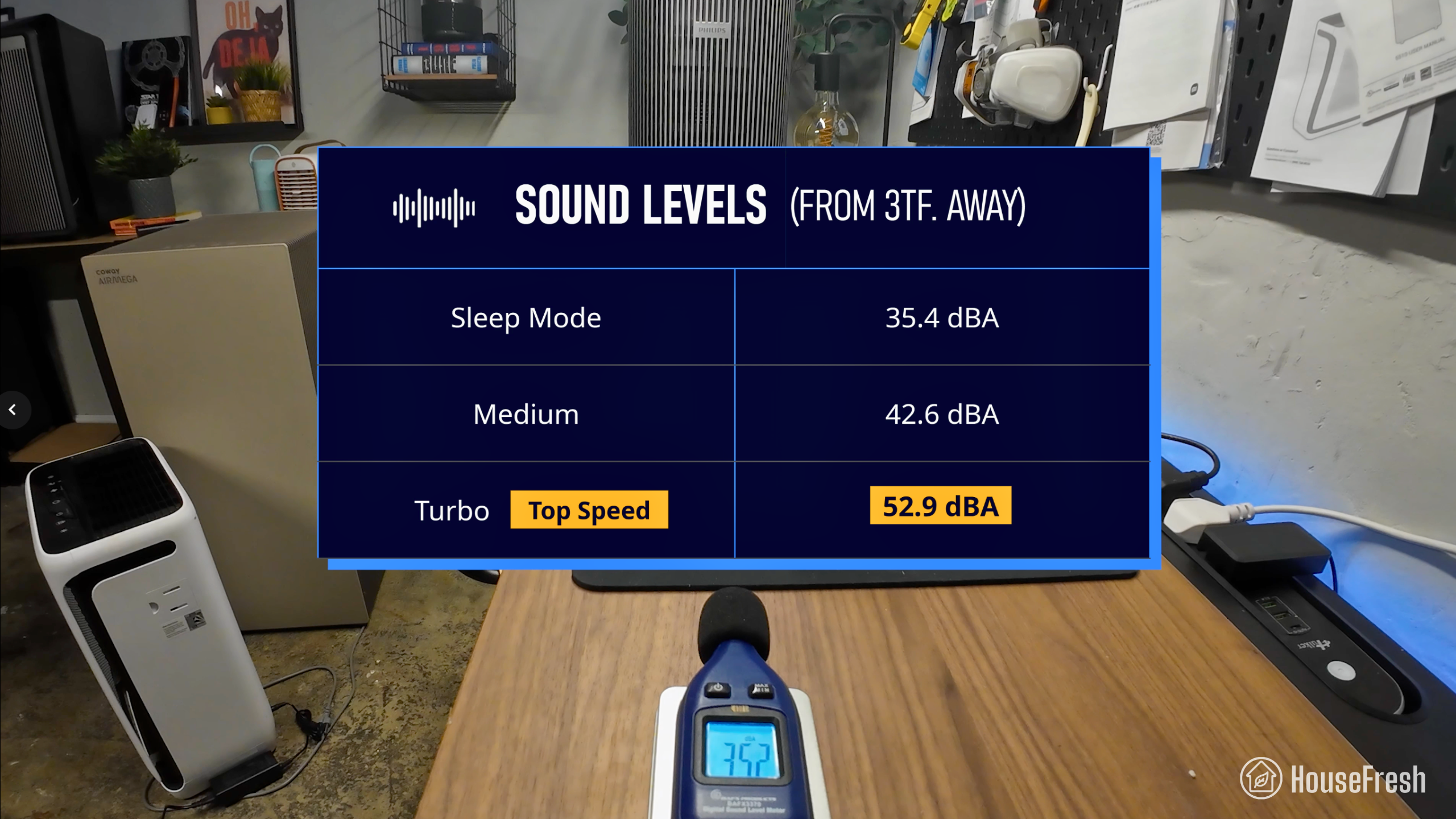
The 3200 hit 52.9 dBA at Turbo speed, so it’s much quieter than the older 3000i (59.2 dBA).

The 3200 is the second quietest mid-sized air purifier on our table outmatched only by the PC fan powered Luggable XL-7 from CleanAirKits (38.8 dBA).
It generates 42.6 dBA at Medium speed and it took 35 minutes to reach PM1 zero in our test room.
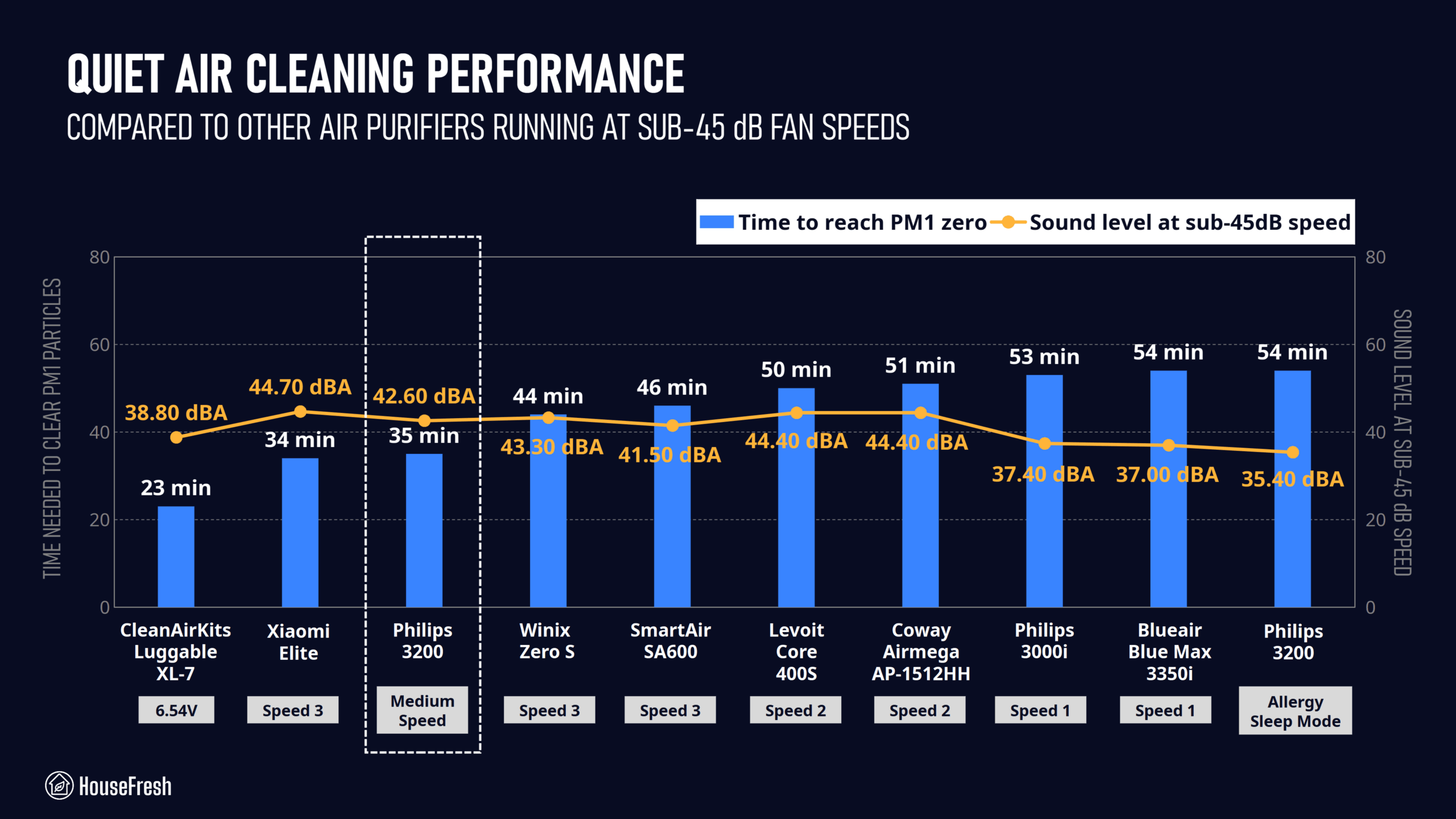
Although it’s no match for the incredible power of the Luggable XL-7 with its seven Cooler Master Sickleflow 120 fans, it’s fair to say that the Philips 3200 offers excellent performance at quiet fan speeds.
Long-term running costs
Running a Philips 3200 Series will cost you £131.82 per year, combining energy and filter replacement costs.
We used our energy meter to record how much electricity the Philips 3200 pulls at each fan speed and also while on standby:
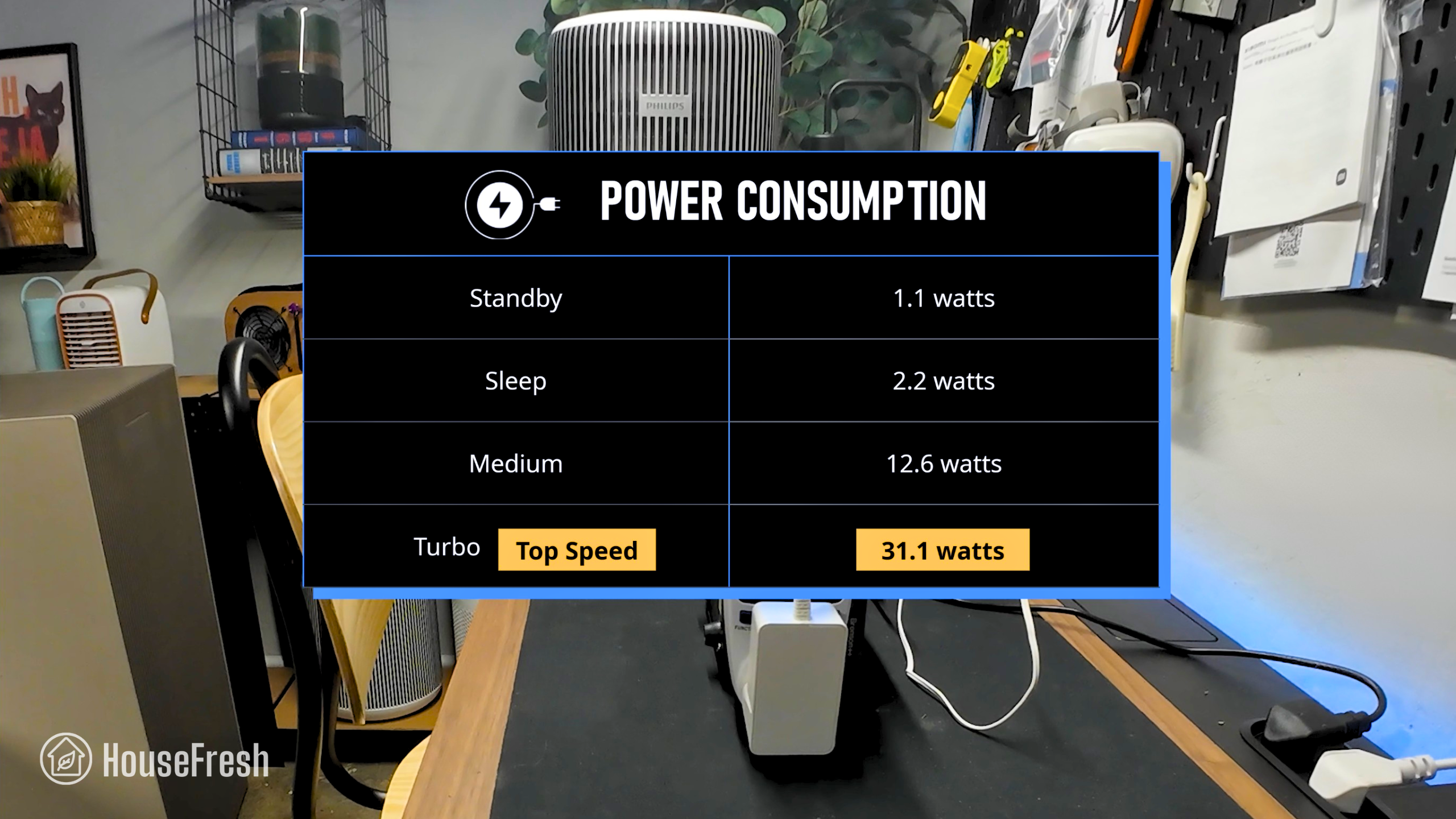
At Turbo speed, the 3200 Series pulls 31.1 watts, so if you were to leave it running 24/7 at this speed for one year will add £71.83 to your energy bill, based on the November 2025 average UK electricity price cap of £0.26 per kWh.
Here, the Philips 3200 also does well against other similarly priced mid-sized models, although it still uses more energy than the Blueair 3350i and the European version of the Levoit Core 400S.
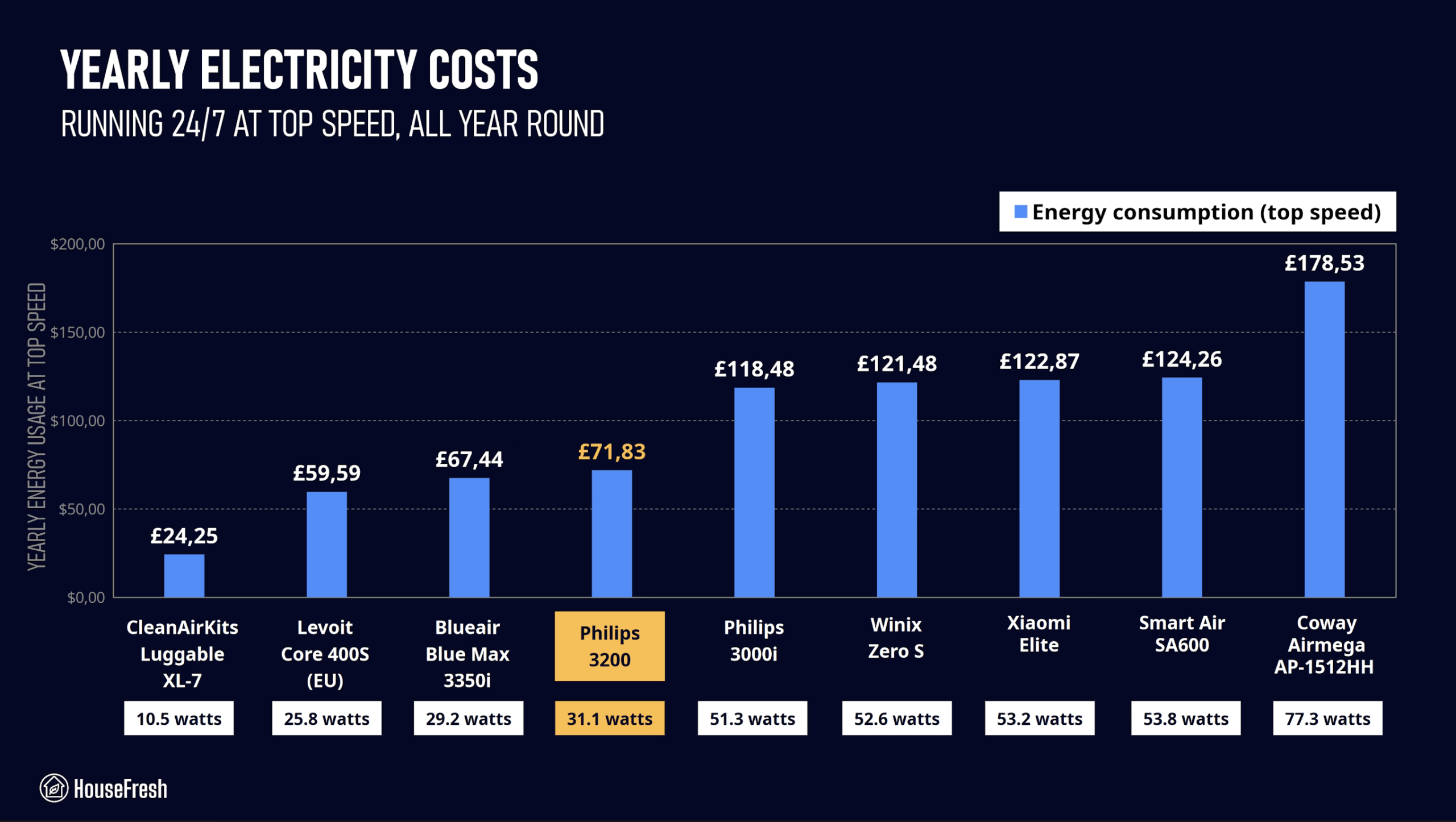
But let’s look at the other main factor that affects yearly running costs: the filter replacements. According to Philips, you can expect to change filters every 12 months and you can buy a new filter set that includes two filters for £59.99.
We can add this to energy costs to work out the total yearly cost and compare it with other mid-size devices we have tested:
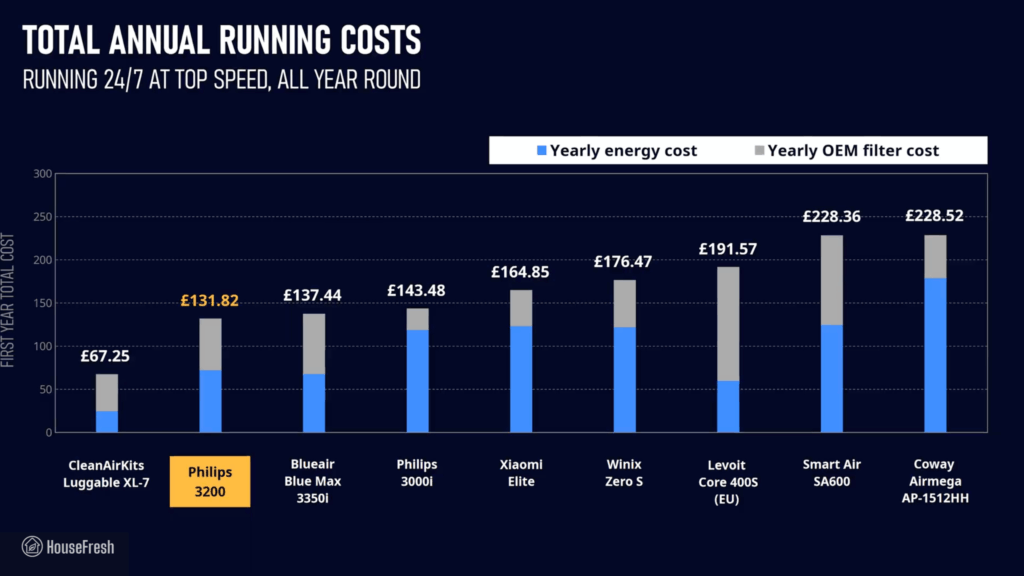
When accounting for both energy and filter replacements, the Philips 3200 is one of the more affordable mid-size air purifiers to run.
Bottom line: Should you get a Philips 3200 Series?
After re-testing everything about this air purifier, I can confidently say it still holds its own against newer models — especially given its price.
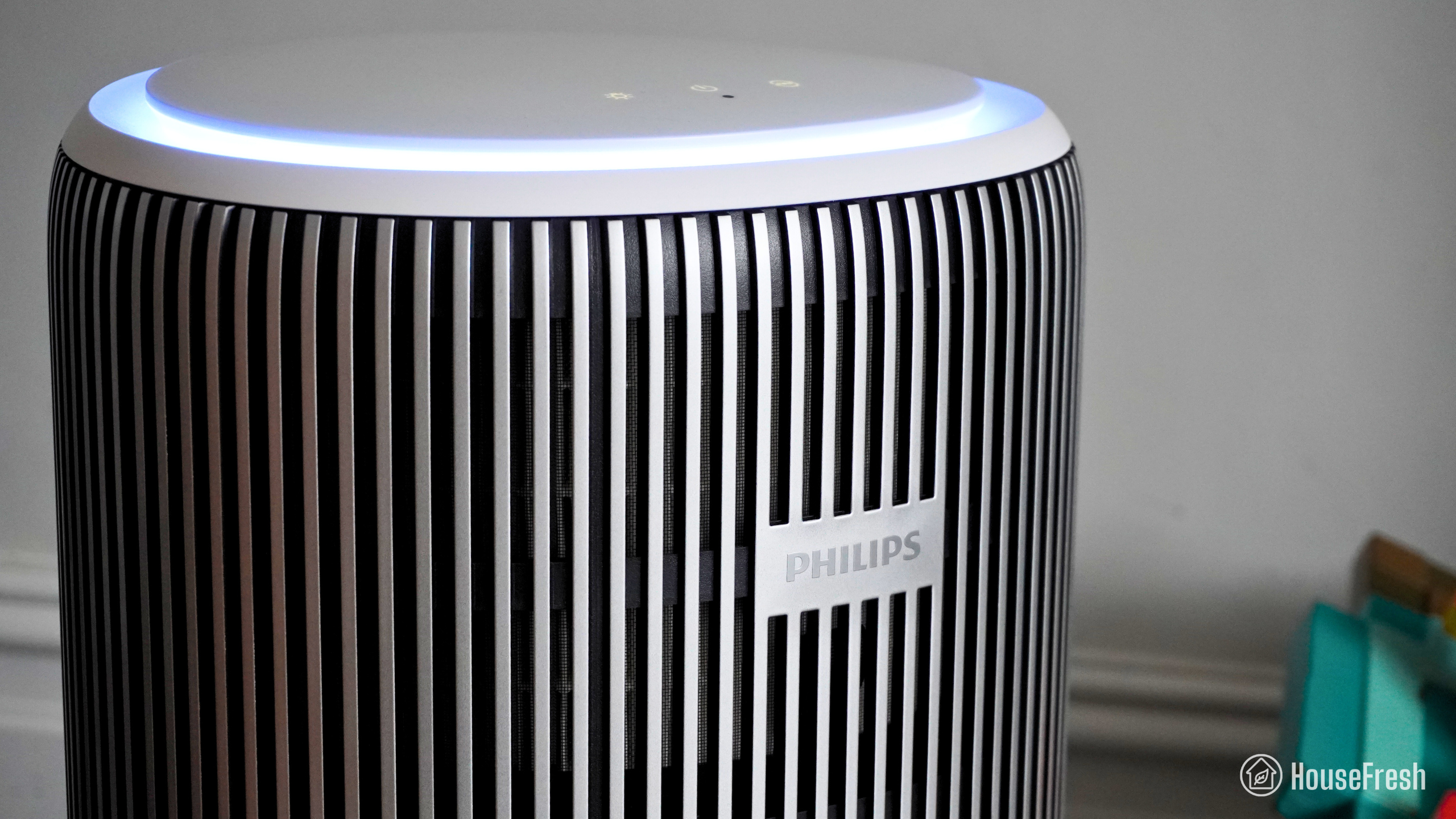
On paper, the 3200 certainly looked good, but it took me a while to make the decision to buy it because I was super disappointed to learn that Philips had discontinued the 3000i after just a few years on the market.
But I reached out to Philips, and they said that the 3200 is here to stay. They also confirmed that they have no plans to discontinue the filter replacements for the 3000i, so that is some good news for UK owners of the 3000i 🙂
After spending a few months with the Philips 3200 at home, I am convinced that it’s a significant upgrade to the now-discontinued 3000i.
You get the same level of air cleaning performance at a lower initial price with half the energy usage and cheaper long term costs:
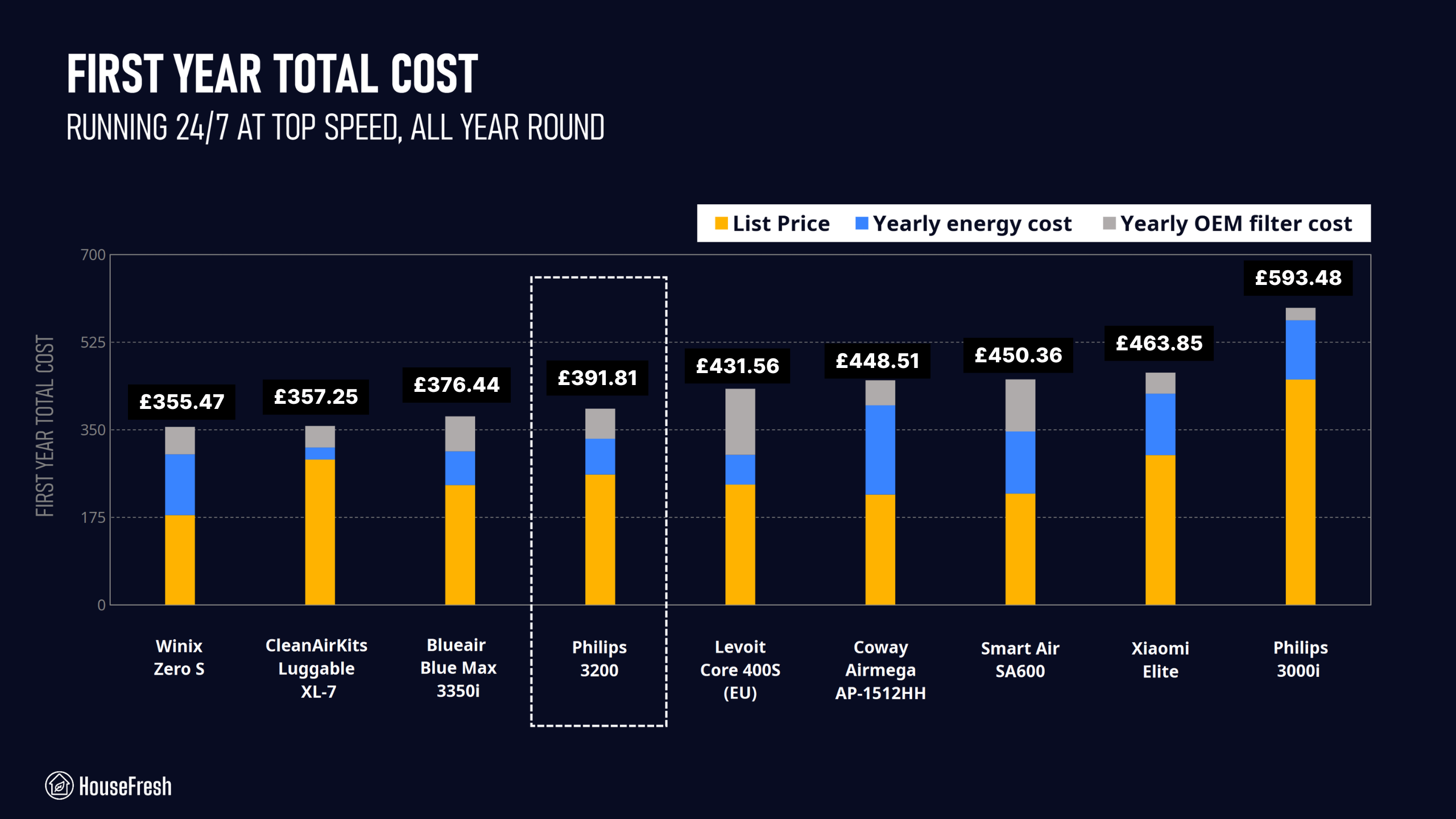
However, finances aside, the best feature of the 3200 is how well it performs at quiet fan speeds below 45 dBA.
The use of two fans allows this device to outperform most mid-size models available in the UK and Europe.

It is clear as well that Philips has been upgrading their smart features and I’m a big fan of their Allergy Sleep mode, which dials up the CADR of the default Sleep mode.
And even though I thought the lamp function would be gimmicky at first, I was surprised by the quality of the light and I soon found myself scheduling the light through the app as I do with my Philips Hue lights.
However, if you don’t care about smart functions, apps and lights, then you should definitely check out the Luggable XL-7 from CleanAirKits, which has recently been introduced to the UK and Europe.
Or if you’re looking for a traditional air purifier that offers better bang for your buck, then you should check out the Winix Zero S, which costs £179 and offers similar performance to the 3200 without the fancy app.
But for those of you who want it all (looks, smart features, app connectivity and a nightlight), then you can’t go wrong with the Philips 3200.
If you think the 3200 is the right air purifier for you, please use our affiliate link to buy one to help support the work we do here at HouseFresh at no extra cost to you. And if you have any questions about this or any other air purifier, please drop them in the comments below and I’ll get back to you as soon as I can.


